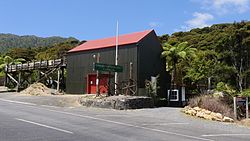Coromandel (New Zealand)
| Coromandel | ||
| Geographical location | ||
|
|
||
| Coordinates | 36 ° 46 ′ S , 175 ° 30 ′ E | |
| Region ISO | NZ-WKO | |
| Country |
|
|
| region | Waikato | |
| District | Thames-Coromandel District | |
| Ward | Coromandel-Colville Ward | |
| Residents | 1 503 (2013) | |
| height | 3 m | |
| Post Code | 3506 | |
| Telephone code | +64 (0) 7 | |
| UN / LOCODE | NZ CMV | |
| Photography of the place | ||
 Kapanga Road , main shopping street |
||
Coromandel is a small town with around 1500 inhabitants (2013) on the peninsula of the same name in the north of the North Island of New Zealand .
Origin of name
The name of the city goes back to the British ship HMS Coromandel , which anchored for the first time in Colville Bay on June 13, 1820 to take on board the Kauri wood, which is valuable for the shipbuilding of the Royal Navy . 12 months later, the HMS Coromandel traveled back to England fully loaded and left her name to the city.
geography
Coromandel is located on the west coast of the Coromandel Peninsula , sheltered at the end of the natural harbor Coromandel Harbor . Thames , the next largest city, is 54 km south and Auckland , accessible by ferry, is around 60 km west of Coromandel . The most important traffic connection for the place is the New Zealand State Highway 25 , which establishes a connection over the west coast to Thames , as well as connects Coromandel with the places of the east coast of the peninsula. The town has access to the Firth of Thames via Coromandel Harbor and a little further north to the Hauraki Gulf .
Administratively, Coromandel belongs to the Thames-Coromandel District and thus to the Waikato region .
history
The first decades of Coromandel were heavily influenced by the trade and processing of wood. When Charles Ring finally found gold in Driving Creek near the city in 1852 , Coromandel caught the gold rush and the boom brought a certain wealth for a short time, because difficulties in extracting the gold from the quartz fields made further yield unattractive . With the end of the gold rush and the end of the exploitation of the forests, Coromandel also lost its importance. What remains are some historical buildings from days gone by and memories of old times.
port
Coromandel has a pier with a couple of moorings. A couple of fishing boats or charter boats with anglers leave from there. The Coromandel Harbor is mainly used by sailors and partly for oyster farming . The use of the pier and large parts of the natural harbor is heavily dependent on the tides .
The place today
Coromandel can be easily reached by ferry from Auckland and is of great recreational value for city dwellers. On weekends and in the holiday season, the place lives from tourism. Artists and artisans have also settled in Coromandel , who give the place a special flair with their offers. For the northern part of the Coromandel Peninsula , Coromandel is the only place for services and shopping.
See also
Web links
- Coromandel Town Aotearoa New Zealand - History . Coromandel Information Office,accessed on January 29, 2017.
Individual evidence
- ↑ 2013 Census QuickStats about a place: Coromandel . Statistics New Zealand , accessed January 29, 2017 .
- ^ A b Coromandel Town Aotearoa New Zealand - History . Coromandel Information Office , accessed on January 29, 2017 .
- ↑ Topo250 maps - Auckland - Hamilton - Coromandel . Land Information New Zealand , accessed January 29, 2017 .
- ↑ a b Karangahake Gold Mining . IPENZ Engineering Heritage , accessed on January 29, 2017 (English).
- ^ Coromandel Town . Destination Coromandel , accessed on January 29, 2017 .


